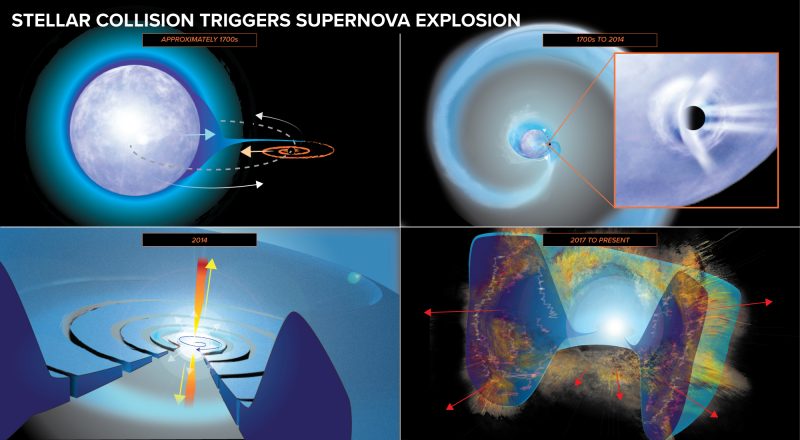
Astronomers have pieced together the fascinating history of a centuries-long death dance between two massive stars, 500 million light-years away. That’s according to the National Radio Astronomy Observatory (NRAO) in Socorro, New Mexico, which announced the new work on September 2, 2021. The evidence suggests that a black hole or neutron star spiraled into the core of its companion star. In doing so, it caused the companion to explode as a supernova. Astronomer Dillon Dong of Caltech, lead author on a new paper reporting the discovery, commented:
Theorists had predicted that this could happen, but this is the first time we’ve actually seen it.
The peer-reviewed journal Science published the study on September 3.
Data from the Karl G. Jansky Very Large Array (VLA), a radio observatory near Socorro, New Mexico, first tipped off these astronomers. A multi-year project called Very Large Array Sky Survey (VLASS) began at the VLA in 2017. Dillon Dong and colleagues were examining images from VLASS. They noticed an object shining brightly in radio waves. But, they noticed, this object hadn’t appeared in an earlier VLA survey. At that point, they became curious.

So they looked further at the object, which is designated VT 1210+4956. For the new observations, they used both the VLA and the Keck telescope in Hawaii. They determined that the bright radio emission from VT 1210+4956 was coming from the outskirts of a distant, star-forming galaxy, approximately 500 million light-years from Earth. Looking further, they later found that, in 2014, an instrument aboard the International Space Station had also detected a burst of X-rays coming from VT 1210+4956. NRAO explained:
The data from all these observations allowed the astronomers to piece together the fascinating history of a centuries-long death dance between two massive stars. Like most stars that are much more massive than our sun, these two were born as a binary pair. The closely orbit each other. One of them was more massive than the other and evolved through its normal, nuclear fusion-powered lifetime more quickly. It exploded first as a supernova. And it left behind either a black hole or a superdense neutron star.
The black hole or neutron star’s orbit grew steadily closer to [the second star], its companion. And, about 300 years ago [from our earthly perspective] the black hole or neutron star entered the [second star’s] atmosphere, starting the death dance. At this point, an interaction began, which sprayed gas away from the [second star] into space. The ejected gas, spiraling outward, formed an expanding, donut-shaped ring, called a torus, around both stars.
Eventually, the astronomers said, the black hole or neutron star made its way inward to the second star’s core. It disrupted the nuclear fusion that was enabling the second star to shine, and that was keeping its core from collapsing under its own gravity. Without fusion, the second star’s core did collapse and explode as a supernova. Dong explained:
The companion star was going to explode eventually. But this merger accelerated the process.
The material ejected by the 2014 supernova explosion moved much faster than the material thrown off earlier from the companion star. By the time VLASS observed the object, the supernova blast was colliding with that material, causing powerful shocks that produced the bright radio emission seen by the VLA. Gregg Hallinan of Caltech explained:
All the pieces of this puzzle fit together to tell this amazing story. The remnant of a star that exploded a long time ago plunged into its companion, causing it, too, to explode.

Bottom line: Star collision triggers supernova! Dramatic evidence that a black hole or neutron star spiraled its way into the core of a companion star and … boom!
Source: A transient radio source consistent with a merger-triggered core collapse supernova











